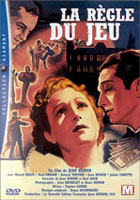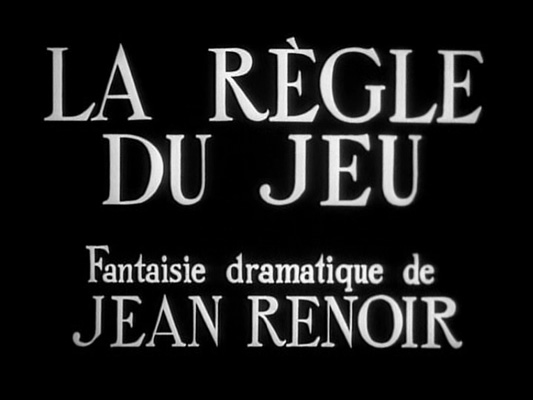
(Rules of the Game | Die Spielregel)
by Jean Renoir

France 1939
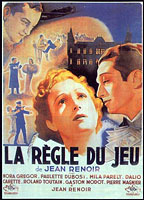
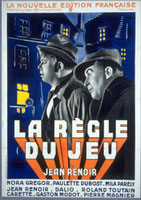
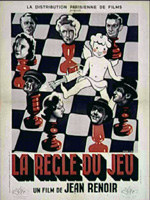

(click poster on the left to enlarge)
|
Director:
|
Jean Renoir | |
|
Producer:
|
Claude Renoir | |
|
Production Companies:
|
N.E.F. (La Nouvelle Edition Française) | |
|
Screenplay:
|
Jean Renoir; with the collaboration of Carl Koch, Camille François and the actors | |
|
Cinematographer:
|
Jean Bachelet (b/w, 1.37:1) Jean-Paul Alphen (cadreur); Alain Renoir, Jacques Lemare (assistants cadreurs) |
|
|
Editor:
|
Marguerite Houlet-Renoir; Marthe Huguet (Assistante-monteuse) | |
|
Music Score:
|
Roger Désormières (arrangeur) Non-Original Music by Wolfgang Amadeus Mozart (from: Dreizehn deutsche Tänze, K. 605, No. 1); G. Claret et Camille François ("C'est la guinguette"); Monsigny (Air de la poupée mécanique); Air 1900 ("En revenant d'la pèche, d'la pèche au bas-Meudon"); Cors de chasse; Desormes et Delonnel-Garnier ("En revenant d'la revue"); Frédéric Chopin (Valses); Camille Saint-Saens ("Danse macabre"); E. Rosi ("Tout le long de la Tamise"); Salabert ("Nous avons l'vé l'pied"); Vincent Scotto ("A Barbizon"); Johann Strauß ("Die Fledermaus" (musique du limonaire); Monsigny ("Le Déserteur") |
|
|
Sound:
|
Joseph DeBretagne | |
|
Art Director:
|
Eugène Lourié; Max Douy (Assistant décorateur) | |
|
Costumes:
|
Coco Chanel | |
|
Assistant Director:
|
Henri Cartier-Bresson, André Zwobada | |
|
Cast:
|
Marcel Dalio (Le marquis Robert de La Chesnaye), Nora Gregor (Christine de La Chesnaye), Roland Toutain (André Jurieu), Jean Renoir (Octave), Mila Parely (Geneviève de Marrast), Odette Talazac (Charlotte), Pierre Magnier (Le général), Pierre Nay (M. de Saint Aubin), Richard Francoeur (M. de La Bruyère), Claire Gérard (Mme de La Bruyère), Paulette Dubost (Lisette), Gaston Modot (Schumacher), Julien Carette (Marceau), Eddy Debray (Corneille), Anne Mayen (Jackie) | |
|
Runtime:
|
113 min | |
|
Premiere:
|
7 July 1939 (Aubert Palace et Colisée Paris, 100 min cut) 23 April 1965 (Premiere of the complete restored cut, Studio Medicis Paris) Budget: 5.500.000 francs (1939) |
|
|
Awards:
|
Bodil Awards 1966 Bedste europæiske film Originally released at 113 minutes, but quickly recut due to political pressions and popular outcry and eventually pulled from circulation by the Nazi during French occupation. Various cuts exists, ranging in length from 80 to 110 minutes. |
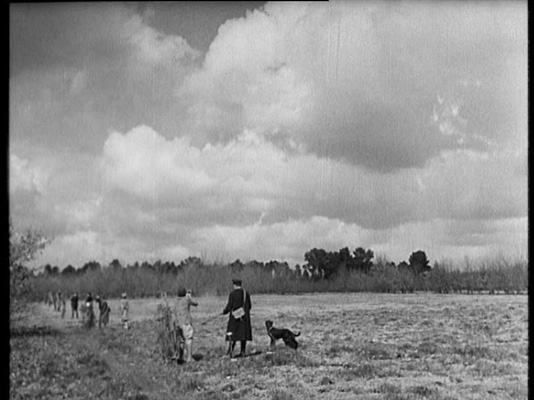
|
"Now often cited as one of the greatest films ever made, Jean Renoir's La Règle du jeu / Rules of the Game was not warmly received on its original release in 1939: audiences at its opening engagements in Paris were openly hostile, responding to the film with shouts of derision, and distributors cut the movie from 113 minutes to a mere 80. It was banned as morally perilous during the German occupation and the original negative was destroyed during WWII. It wasn't until 1956 that Renoir was able to restore the film to its original length. In retrospect, this reaction seems both puzzling and understandable; at its heart, Rules of the Game is a very moral film about frequently amoral people. A comedy of manners whose wit only occasionally betrays its more serious intentions, it contrasts the romantic entanglements of rich and poor during a weekend at a country estate. ... Among the upper classes, infidelity is not merely accepted but expected; codes are breached not by being unfaithful, but by lacking the courtesy to lie about it in public. The weekend ends in a tragedy that suggests that this way of life may soon be coming to an end. Renoir's witty, acidic screenplay makes none of the characters heroes or villains, and his graceful handling of his cast is well served by his visual style. He tells his story with long, uninterrupted takes using deep focus (cinematographer Jean Bachelet proves a worthy collaborator here), following the action with a subtle rhythm that never calls attention to itself. The sharply-cut hunting sequence makes clear that Renoir avoided more complex editing schemes by choice, believing that long takes created a more lifelike rhythm and reduced the manipulations of over-editing. Rules of the Game uses WWI as an allegory for WWII, and its representation of a vanishing way of life soon became all too true for Renoir himself, who, within a year of the film's release, was forced to leave Europe for the United States."
— Mark Deming, All-Movie Guide "... 'A film in which all the intrepidity of the avant-garde survives, in which, from time to time, something like an echo of L'Age d'or can be discerned.' (Jacques Brunius). Indeed, there is much to link Rules of the Game to L'Age d'or (by way of La Vie est à nous). Once again the upper-class are at their most ridiculous during a typical soiree (here, a costume ball, the artifice made plain); like the comical Madame LaPlante, they mangent de tout though their play is as mechanical as one of the Marquis' musical toys. Behind the scenes, the skirmishes of lovers reveal the anarchy of desperation, after the rules of the game have been broken by the pilot André in his singleminded pursuit of l'amour fou. But Renoir is even more cynical than Buñuel, if that were possible; 'André is a hero in the air but hopeless on the ground, like all modern heroes,' reports Octave, the film's real, doomed hero (played by Renoir himself). Renoir described this brilliant tragicomedy as 'a sort of reconstructed documentary on the condition of a society at a given moment,' that being 1939, on the eve of a disastrous phase of French history." "La Règle du jeu [is] a film which forms the culmination of a remarkable decade of French film making. If Toni reveals most clearly the naturalistic tendency of Renoir's art, La Règle du jeu shows his theatrical impulse. Here, at the age of forty-five, after having made fourteen films in the preceding eight years and now working without constraints for his own production company, Renoir was free to express himself fully. Significantly he chose the form of a 'dramatic fantasy' in which the theatrical roots of his style - the debt to Musset, Marivaux and Beaumarchais - are very apparent: in the function of the dialogue, the division of characters into masters and servants, the 'play within a play' structure, the use of both improvisation and very formal placing of characters, and even in the articulation of an action played out in depth and time, allowing genuine performances from the actors. But while La Règle du jeu presents itself as a contrivance, a game with emotions, a toying with reality and illusion, it is also a self-portrait of rare depth, not least thanks to Renoir's own appearance in the key role of Octave, the go-between who straddles the worlds of masters and servants and inadvertently triggers off the final tragedy. At the same time the film - like Le Crime de M Lange or La Marseillaise - is a precise reflection of the time when it was shot, in this case the brief moment between the Munich agreements and outbreak of war. As the director has himself aptly observed, he was absolutely influenced and troubled by the state of mind of French society, but felt that 'one way of interpreting this state of mind to the world at that moment was precisely not to talk of the situation, but instead to tell a frivolous story'. ... The action moves from bedroom farce to a tragic conclusion, from the ruthlessness of the hunt sequence to the initially good-natured fun of the party entertainments, the beauty of the exteriors and the artificiality of the studio interiors, the quick cutting of the shooting during the hunt and the long takes in depth of the dialogue sequences, and so on. In acting style, the intense professionalism of such performers as Carette or Dalio is set against the clumsy amateurism of Nora Gregor (an Austrian princess in real life) and Renoir himself as the bear-like Octave. ... The complexity of the film is enormous and it repays multiple viewings. When first shown, La Règle du jeu was a total commercial failure - perhaps the worst in Renoir's career - but since then it has earned universal acclaim and now stands unchallenged as the summation of a decade of French film making which is far richer than any simple notion of poetic realism could define." "By February 1939 it no longer seemed evident that the surrender of Czechoslovakia to Hitler at Munich had "saved the peace." Soon a fatalistic mood of doom would hang over Europe. In this atmosphere Jean Renoir, anticipating war and deeply troubled by the state of mind he felt around him, thought he might best interpret that state of mind by creating a story in the spirit of French comic theatre, from Marivaux to Musset, a tradition in which the force which sets every character in motion is love and the characters have no other occupation to interfere with this pursuit. The result was The Rules of the Game, a dazzling accomplishment, original in form and style, a comic tragedy, absurd and profound, graced by two of the most brilliant scenes ever created. It is also, in the words of Dudley Andrew, "the most complex social criticism ever enacted on the screen." A total failure in 1939, The Rules of the Game now ranks as one of the greatest masterpieces of world cinema. ... Though the world of the film seems at times sheer chaos, The Rules of the Game, seen whole, is lucid and as precisely constructed as the Marquis' mechanical instruments. Unfortunately, the Parisians of 1939 never saw it whole. Later in his life Jean Renoir could laugh as he pronounced The Rules of the Game "a magnificent flop, perfect, complete" for by then his "frivolous drama" was hailed as a masterwork. But in 1939 he was not amused. The distributor had cut eight minutes from Renoir's final cut before the film's release and at the premiere, the Parisian audience howled and whistled and threw things at the screen. In a week, ten more minutes had been cut from the film but audiences still hooted. In a few more weeks the exclusive opening run ended; this most ambitious production of the year had quickly become a commercial disaster. Renoir was so discouraged, he thought he must either give up cinema or leave France. He did leave for Hollywood a year later to avoid working under the Nazi occupation, leaving the film to its fate." "Depth of focus is one of Renoir's most important techniques for developing the uncontrollable events that grow out of the complicated interactions among individuals. In the entire film there are only 337 shots, which means that Renoir lets the events unfold uninterruptedly before the camera instead of restructuring experience through montage. He is interested in showing that each character has his own justified perspective, which must be seen in relationship to his environment and the people with whom he interrelates." "Autre grande nouveauté de La Règle du Jeu, la continuité n'est plus établie selon le modèle en usage, issu de la dramaturgie classique. Au développement linéaire du drame construit, Renoir substitue un développement à lignes brisées, 'croisées', comme l'exigeait, en somme, son sujet La Règle du Jeu comporte des 'passes', des 'contres', illisibles pour le non-initié, tout un arsenal de coups, qui se croisent eux aussi. Ce qu'on a appelé l'enchevêtrement des actions est non pas désordre, mais un ordre voulu, complexe, concerté, rigide comme un protocole. Cette technique de construction filmique, qui tient à la fois de la technique de l'ancien 'maître à danser' et du 'maître d'armes', était ici en situation, A SA PLACE..." La Règle du Jeu de Jean Renoir — Dossier établi par Roger Viry-Babel, Institut Européen de Cinéma & d'Audiovisuel Université Nancy 2 The Online Jean Renoir Resource Centre: La regle du jeu (1939) |
|
|
||
|
Distribution:
|
Editions Montparnasse / Buena Vista / Collection Diamant Region 2,3,4,5,6 (France) |
|
|
Runtime:
|
111:42 min (+ 4% PAL Speedup = 117 min) |
|
|
Video:
|
1.29:1/4:3 FullScreen Average Bitrate: 4.84 mb/s PAL 720x576 25.00 f/s |
|
|
Audio:
|
Français MPEG-2 2.0 Mono | |
|
Subtitles:
|
English, Deutsch, Español | |
|
Features:
|
• Documentary: La règle du jeu de Jean Renoir: Une analyse du film par l’image, by Pierre-Oscar Levy with texts by Jean Douchet, from the 1987 TV series Image par Image (42:36 min) • Film Posters • DVD-ROM: Biographies & filmographies • Complete Crew & Cast • Internet Links |
|
| DVD Release Date: 26 April 1999 Keep Case Chapters: 18 DVD Encoding: PAL Region 2,3,4,5,6 SS-DL/DVD-9 (4.83 GB/film, 7.34 GB/total) |
||
|
Comment:
|
The DVD presents "La Règle du jeu" in the uncut version that was restored by film historians Jean Gaborit and Jacques Durand. The print is rather worn, with many speckles, tears and scratches, and there is a considerable amount of film grain. Fortunately though, the digital noise reduction filter has been used with more care than on other releases by Edition Montparnasse, which are close to unwatchable because of the excessive use of DNR. The image is fairly detailed if not a little dark, and there is some greyscale fluctuation in the picture throughout the film. But considering the age of the film, the overall quality is quite good and definitely watchable. The French mono sound is clean. There are English, Spanish and German subtitles.
The main extra is a 42 minute TV documentary recorded in 1987 (with English, Spanish and German subtitles) with film analysis by Jean Douchet (Cahiers du Cinéma) and Pierre Oscar Lévy. It covers the historical context of the film, some of intricacies of the plot, and the symbolism of some of the scenes. Film: ***** out of ***** |
Menu
 |
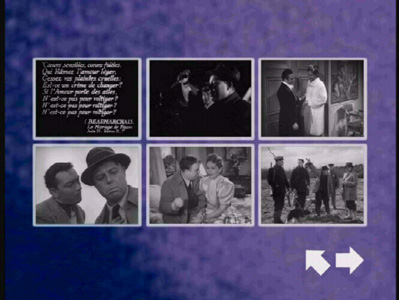 |
Frame 2
 |
Frame 3
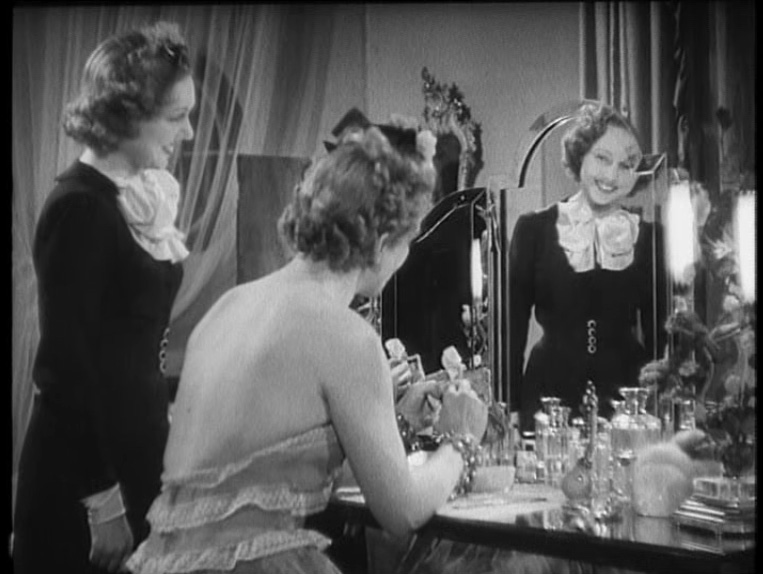 |
Frame 4
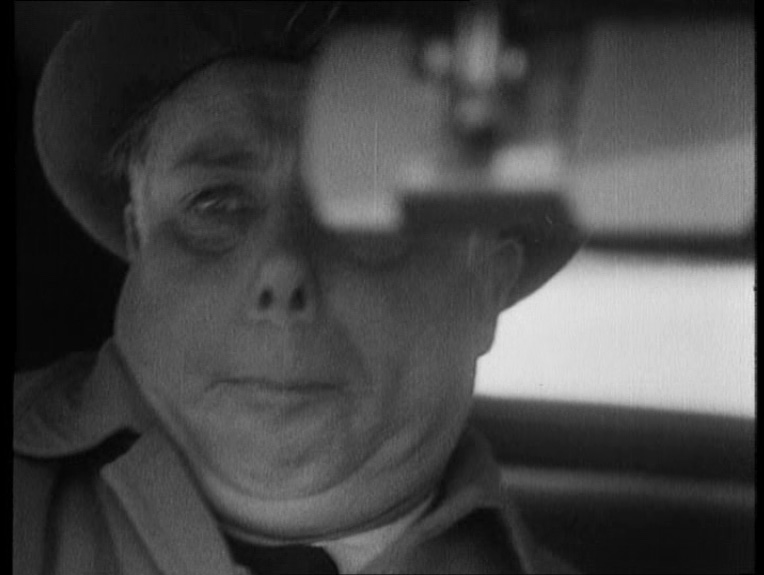 |
Frame 5
 |
Frame 6
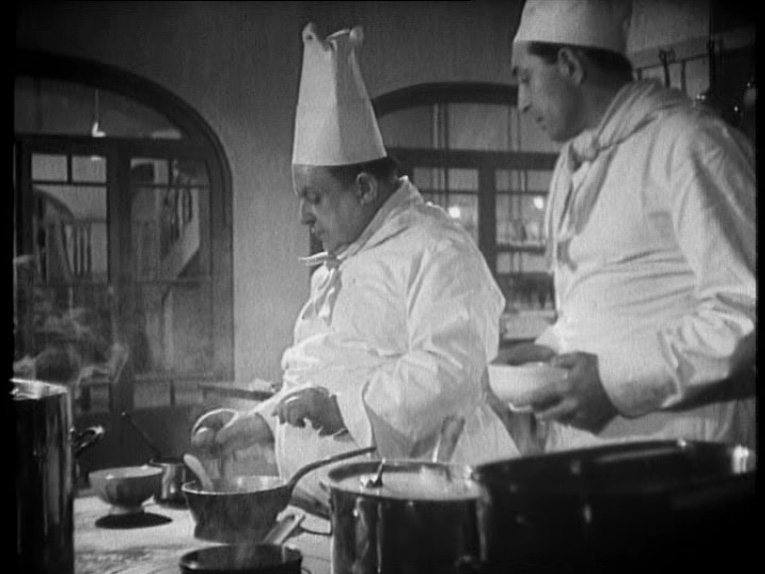 |
Frame 7
 |
Average Bitrate :
4.84 mb/s
No Bitrate Chart available
|
This is a strictly non-professional and non-commercial DVD review. Don't expect industry reference work! All ChiaroScuro captures are taken under MacOS X.2 using VideoLAN and Snapz ProX. For further methodological remarks see DVDBeaver (click on "Methodology"): "We are not a lab and are doing a good a job as our time and energy permits. Thank you for understanding." |
